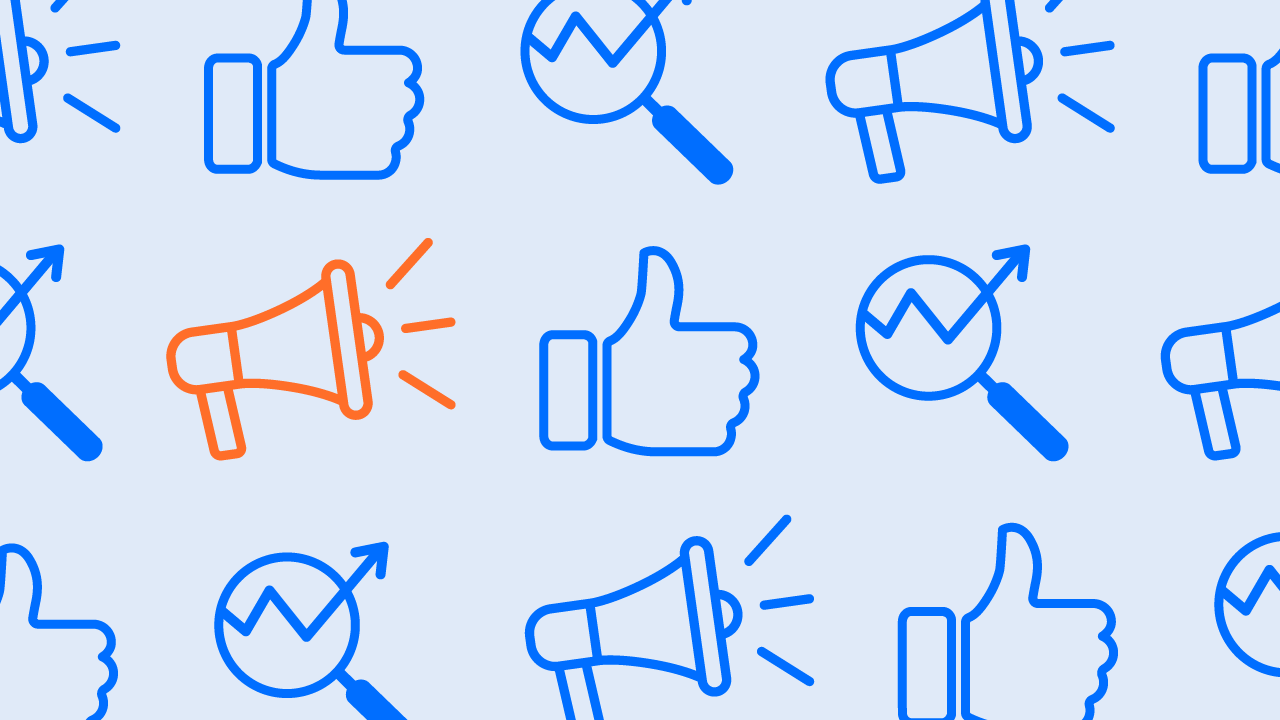Think of brand equity like the popularity of the cool kid in high school. It's not necessarily about their clothes or backpack – those are just products. It's the full image and reputation they've cultivated that makes everyone want to be seen with them.
The stronger your brand equity, the more pricing power and customer loyalty you command. Brands like Volvo (safety) and Coca-Cola (happiness) have almost unparralled brand equity, and drive premium product margins as a result.
Of course, there’s more to it than that. This article will walk you through the basics of brand equity, its four key elements, and how to measure it effectively.
You’ll also get tips for improving your brand's equity, so you can build a strong reputation and boost your business's value in the market.
What is Brand Equity? A Complete Definition
So, what is brand equity? Simply put, it's the intangible value and power a brand name carries beyond its tangible products or services. It's what makes Coca-Cola more than just a sugary drink, and Rolex more than just a fancy watch.
In other words, brand equity is what consumers think and feel about your brand.
For example, luxury brands like Louis Vuitton and Chanel have sky-high brand equity. Consumers happily pay premium prices for their handbags, not because of the materials used, but because of the prestige and status signaled by owning that brand.
Or take a company like Disney. Their brand equity spans beloved characters, theme parks, and a reputation for family-friendly entertainment. It's why parents feel safe plopping their kids in front of a Disney movie or shelling out thousands for a Disney vacation.
If you have strong brand equity, your profits are likely to be healthy, and your consumers will be more likely to pick your product over the competition.
Brand equity is made up of four key components:
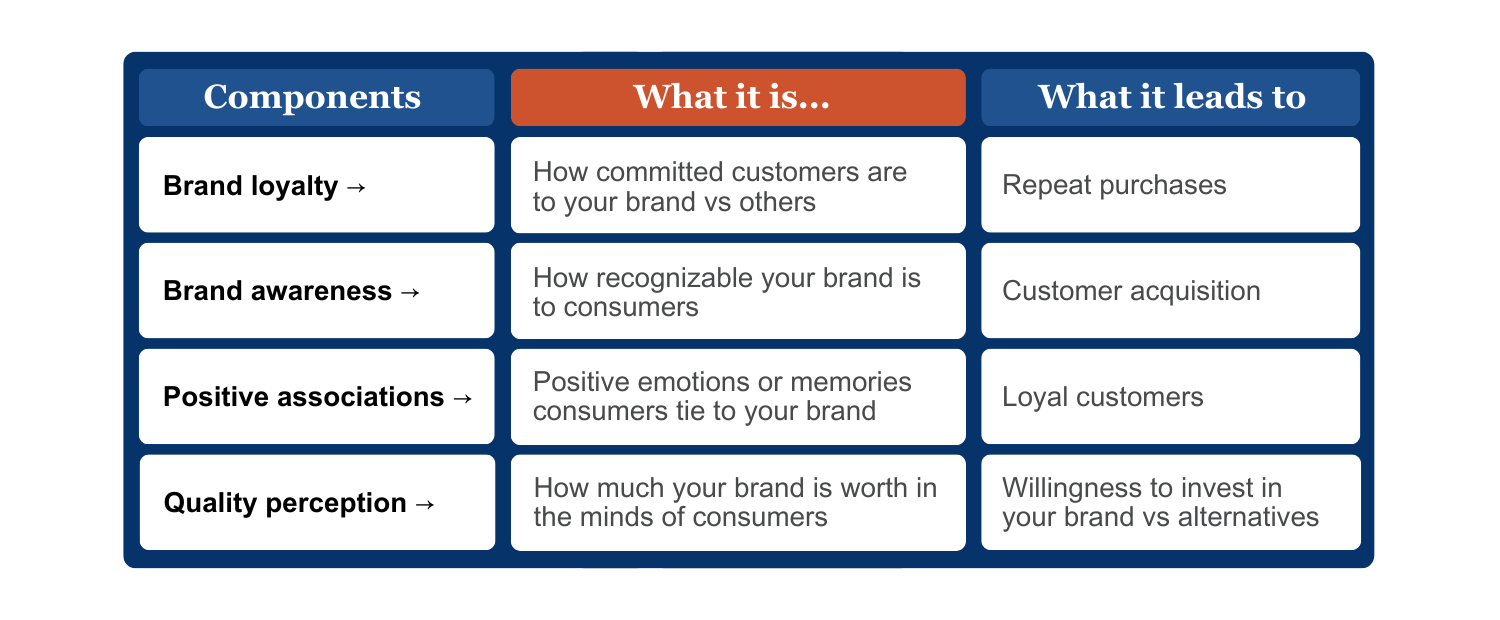
Why is Your Brand Equity Important?
- Competitor differentiation: It enables you to stand out in a crowded market.
- Price justification: Customers are willing to part with more of their hard earned cash for well-known brands and highly regarded products/services.
- Increases customer loyalty: Favorable brand experiences will not only keep customers coming back, but will lead to positive word of mouth.
- Increases sales: Positive brand associations instill a level of trust. Customers are more confident in their purchase, resulting in consistent sales.
- Increases company value: Consistent sales and customer loyalty please investors. Brands with strong equity can unlock more capital and achieve higher valuations.
- Enables successful brand extensions: The stronger your brand equity, the easier it will be for you to successfully launch products and services in future, since you’ll have ready-made consumer interest.
I know what you’re thinking: Brand equity sounds great, how do I build it? Well, as you’ve probably guessed, it’s not exactly easy.
It involves elements of pricing, brand positioning, quality assurance, customer service, and beyond. That’s because brand equity is a business outcome – the result of a whole series of strategies.
Now that you know what brand equity is, let's talk about how you can improve it.
How to Improve Brand Equity: 5 Best Practices
We know increasing your brand power can lead to an increase in sales, customer loyalty, and the overall success of your brand. But, unfortunately, there are no quick fixes to improving your brand equity.
There are, however, some best practices you can follow to make sure your brand is the first one to come to your customers’ mind.
Focus on Quality
Providing high-quality products or services can help improve brand equity by creating a positive reputation for your brand. Have you ever bought a pair of jeans and had them fall apart in a couple of months when you thought they would last for years? Chances are you aren't going to buy from that brand again.
Here are some actionable ways to improve the quality of your product/service:
Quality assurance checks
User testing
Beta programs
Focus groups
Customer service evaluations
Questionnaires
Surveys
Inspections
Audits
Build Brand Awareness
Boosting brand awareness can help build brand equity by making you more recognizable to consumers. You can do this through:
Marketing
Advertising
Public relations
Social media campaigns
Influencer marketing
Content marketing
The more familiar people are with your brand, the more likely they’ll be to grab your product over your competitors’.
Keep reading for more specific examples of this!
Offer Exceptional Customer Service
Customer reviews, user generated content, word of mouth – all of these things carry a lot of currency when it comes to the perception of your brand and its resulting equity.
If your customer service isn’t up to scratch, your prospective customers will soon know about it. A company that offers brilliant customer service is sustainable activewear brand, Tala.
On Instagram alone, they post regular customer service updates to their stories, get customer input on the development of their product, and share their responses to positive customer feedback.
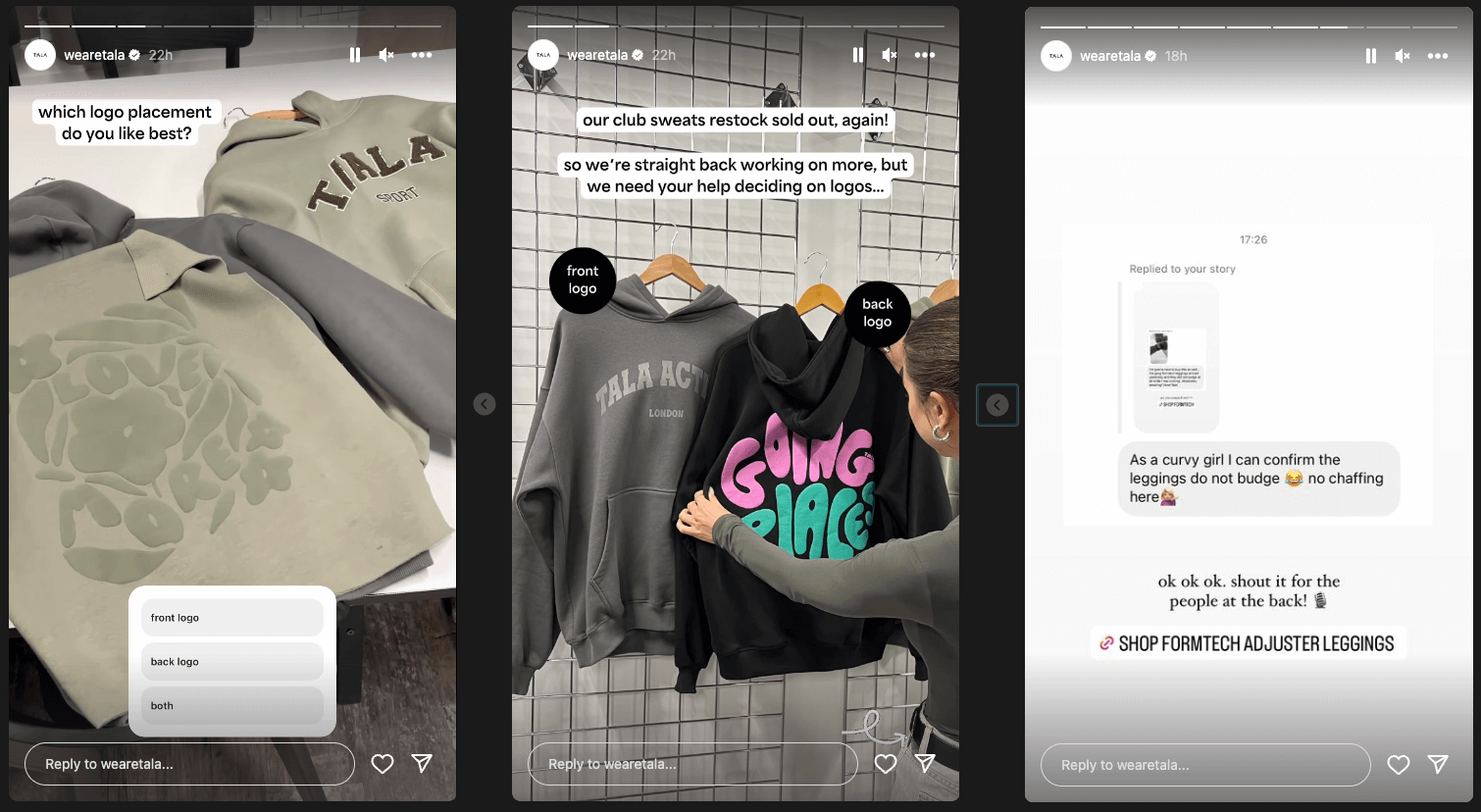
On top of this, they boast an average response time of one hour, while the majority of clothing brands take up to 24.
The result of their superior service? Thousands of positive customer reviews across sites like Trustpilot.
Get your customer service right, like Tala, and you’ll build a fiercely loyal customer base who advocate for your brand at every opportunity.
Build Strong Partnerships
Building a good working relationship with partners and suppliers is a shrewd move in the quest for improving brand equity.
Partnering up with impressive brands will make your brand impressive by association, while working well with suppliers can lead to reduced costs and better quality outputs; both key factors in optimizing brand equity.
Protect Your Brand
If you've ever taken a trip through New York's Time Square, you've seen dozens of people selling luxury goods at a fraction of the retail price.
Chances are they’re cheap knockoffs that aren't nearly the same quality or craftsmanship as the actual brand's products.
Protecting your brand through trademarks, intellectual property, and monitoring the market, can help maintain and improve your brand's equity. If you don't keep an eye on your brand health, its perceived quality can be diminished.
With CisionOne, you can assess the relative risk of negative press and social discussions surrounding your brand with React Score and sentiment analysis.

Brand Equity vs. Brand Value
It’s important to understand that brand equity is not the same as brand value.
Brand value is the financial significance a brand carries, while brand equity refers to the importance a brand holds in the minds of consumers – that said, the two are often related.
Having strong brand equity can undoubtedly increase your brand's value. According to a 2023 report by Statista, the most valuable brands (in billions) worldwide are:
Amazon: 299.28
Apple: 297.51
Google: 281.53
Microsoft: 191.57
Walmart: 113.78
Samsung Group: 99.66
ICBC: 69.55
Verizon:67.44
Tesla: 66.21
TikTok:6 5.67
Chances are that if we asked you to name a computer company, e-commerce site, retailer, electric vehicle, and social media app, these brands would have been on the tip of your tongue because they all have such substantial brand equity.
Three Differences Between Brand Value and Brand Equity
Despite their close relationship, brand value and brand equity differ in a number of ways, including:
Tangibility: Brand equity revolves around customer perception and other intangible elements, while brand value is based on tangible financial metrics.
Time: Brand equity is built steadily over the long term, while brand value can fluctuate based on short-term financial performance.
Measurement: Brand equity’s qualitative attributes make it more challenging to quantify, whereas brand value lends itself to quantitative financial data.
Examples of Positive Brand Equity
Stanley International
A “Stanley Quencher” insulated cup recently went viral after remaining perfectly intact, despite being exposed to extreme heat.
Stanley customer, Danielle Turner, took to TikTok to show the burnt out remains of her car containing the seemingly unaffected tumbler; the cup had in fact insulated the drink so well that the ice inside it had yet to melt.
It wasn’t long before the video had amassed 94m+ views.
Stanley International’s response? Replacing the happy customer’s car for a brand new model.

These two examples illustrate perfectly how Stanley International has managed to build positive brand equity: a quality product (quality perception), and social media publicity (brand awareness).
Focusing on the four key elements of brand equity, let’s take a deeper look at the ways Stanley has built a formidable brand that has seen revenue grow 10x, from $70m in 2019 to $750m in 2023.
Brand Loyalty
Feedback-led Product Development
Stanley honors and rewards brand loyalty. Just as the company was about to retire their now signature product, the Stanley Quencher, due to poor initial sales, dedicated customers at “The Buy Guide” (a review site for mothers) ramped up their advocacy for the product.
Stanley responded by reversing their decision to retire the cup and rewarded “The Buy Guide” team’s loyalty by collaborating with them to redevelop the cup, making it more appealing to a new demographic – working mothers.
Later down the line, Stanley upgraded the Quencher bottled based solely on customer feedback, making it spill-proof and more user-friendly. This led to the launch of their H2.0 model.
The company then launched “Stanley Creates”, allowing customers to design their own Quencher tumblers.
Stanley continues to listen to its customers and prioritizes their feedback for product expansions. This customer-focused strategy has been pivotal in growing the brand and improving its equity.
Brand Awareness
Influencer Marketing
Stanley partnered with well-known influencers, including country music star Lainey Wilson, and Emily Maynard from The Bachelor, to promote the new Quencher bottles. This generated viral interest on platforms like TikTok and Instagram.
Work out how to build an equity diven influencer marketing strategy – download our cheat sheet: The PR Pro's Guide to Influencer Marketing
Social Media Virality
Social media has had a huge part to play in the reinvention of a once low-equity brand. The Stanley cup has been in existence for 110 years, but only in the last five has it seen roaring success.
Going viral multiple times has made the brand much more favorable in the eyes of potential customers, but it is Stanley’s response to that virality which has helped them reinforce their equity.
Partnering with a dedicated TikTok agency, Stanley has made an ongoing commitment to drive brand awareness via social media.
Positive associations
Customer-approved brand collaborations
Stanley clearly did their research when it came to customer purchasing habits, collaborating with major affinity brands Olay and Starbucks to develop limited edition products.
These positive brand associations saw tumblers selling out in minutes, and resulted in Stanley limiting customers to two products per order.
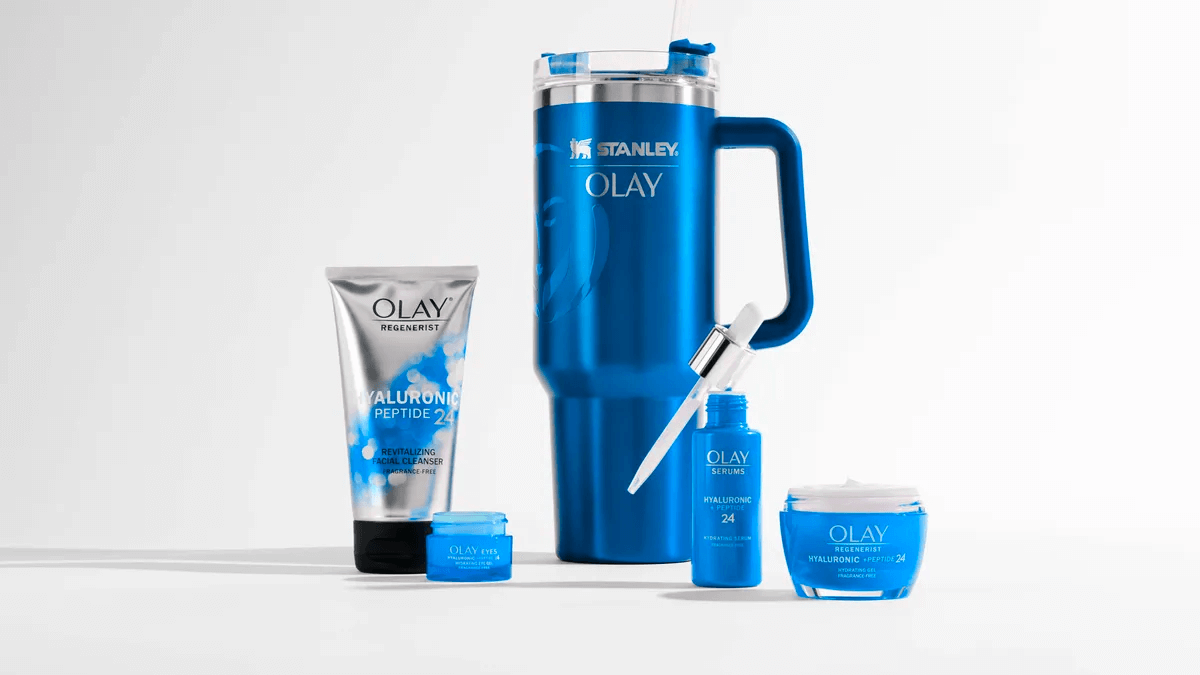
Quality perception
User generated content
With millions of positive user generated TikTok videos surrounding the Stanley Quencher, it’s safe to say the product’s quality has been firmly approved. Customers praise Stanley for their original designs, practicality, and extensive product range.
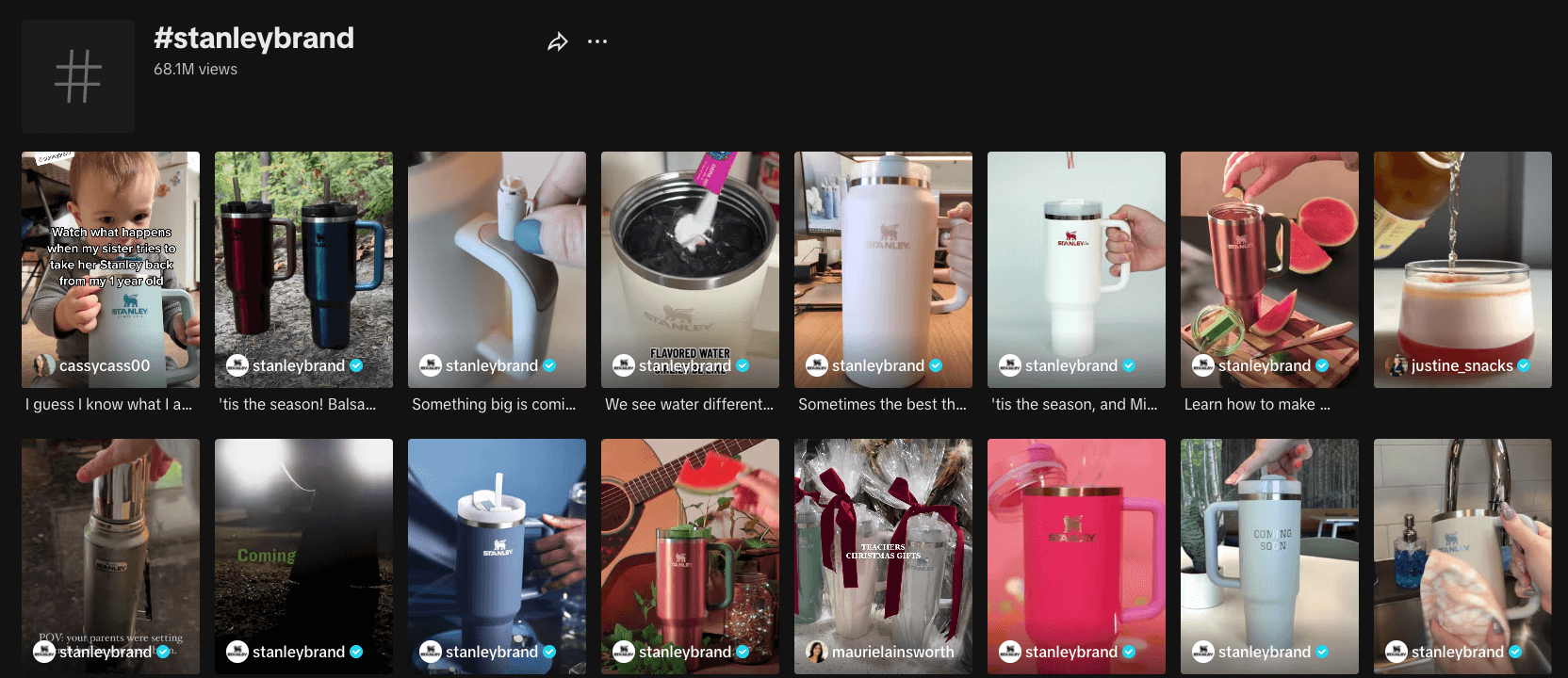
The Outcome
As a result of numerous brand equity plays, Stanley hit 300% growth between 2019 and 2023. At the time of writing, the brand is trending on Google, and is the second most popular hashtag on TikTok…
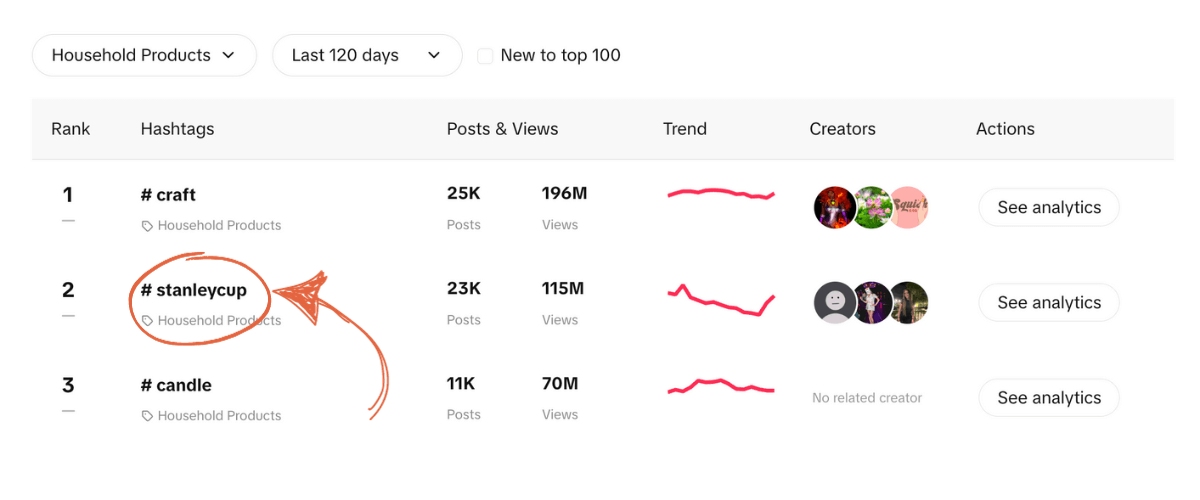
CisionOne data also shows a significant upward trend in mentions this year across social media platforms X, Facebook, and YouTube.
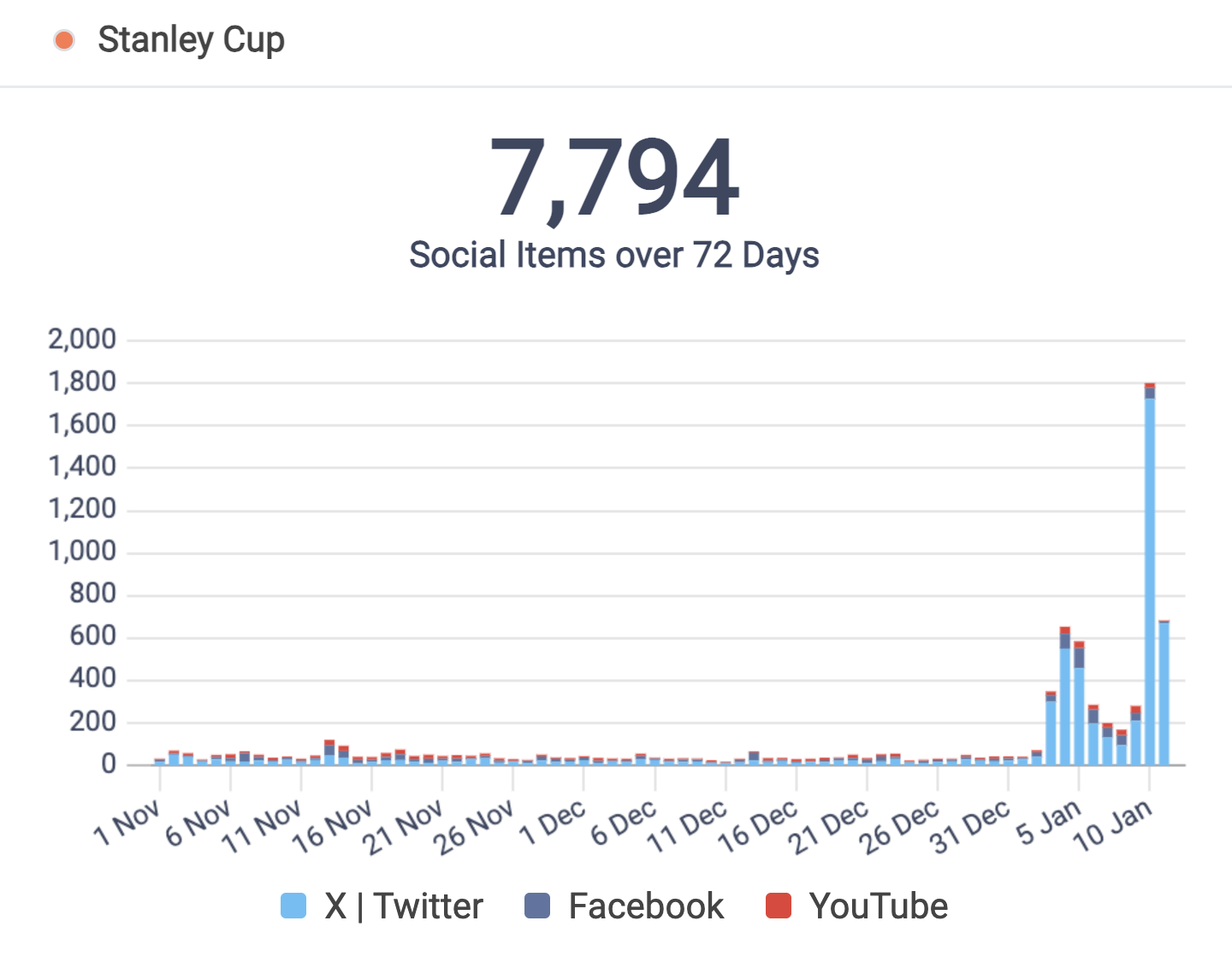
Stanley has successfully managed to harness its customer base to drive home its status as a much coveted item. It has embraced publicity, pushed for originality, and employed scarcity tactics to drive up demand, and in doing so has earned its status as a brand with powerful equity.
Nike
To better understand brand equity, let’s also consider Nike, Inc. Nike’s iconic swoosh logo and “Just Do It” slogan are a universal symbol of athleticism, empowerment, and innovation. Nike’s endorsement by world-class athletes adds to the brand’s allure and reputation. Its social responsibility initiatives showcase dedication to community impact.
The result is positive brand equity that speaks to quality, performance, and sustainability, inspiring customers to reach for that Nike product on the shelf, as opposed to the (often cheaper) alternative. Nike customers won’t hesitate to pay a premium for their cutting-edge Air technology.
Nike’s ability to blend innovative products with a compelling narrative creates strong brand equity that resonates with consumers on an aspirational level. At the end of the day, Nike doesn’t just sell shoes, it sells a mindset and a lifestyle.
How to Measure Brand Equity
So, how do you go about measuring brand equity? It's a complex concept, but there are a few methods and brand KPI examples you can use to calculate it.
Share of Voice
Your brand strength can be measured by its share of voice. Share of voice differs from market share in that it measures brand awareness and not sales. You can assess your brand’s share of voice depending on its percentage of brand awareness across a specific platform.
For example, you could measure SoV across social media, search, print, radio, and so on. Here’s a simple SoV calculation:
(total # of brand mentions / total # of competitors) x100 = SoV
Out of the airlines shown below, British Airways claims the highest SoV across online, print, TV, radio, magazine, and podcasts, with 30.6%.

Retention Rates
Strong customer retention rates are also indicative of a brand with loyal customers and enhanced equity. To work out your CRR, select a date range to measure over and use the following formula:
(# of customers at end of date range / # of customers at beginning date range) x100 = CRR
For example, if you have 10,000 customers at the beginning of the year, and 2,500 by the end, you’d have a CRR of 25% (2,500/10,000 x 100 = 25%). Remember to check industry benchmarks to see how you’re faring compared with the rest of your industry. This will give you a better idea of your brand equity measurement.
Repeat Purchase Rates
Another barometer of customer loyalty, repeat purchase rates can help you assess your brand health. This simple formula will help you work that out:
(total # of customers / # of returning customers) x 100 = RPR
Customer Research
To get a better gauge on your customers’ top pain points, consider investing in market research practices such as social listening, feedback surveys, interviews, and customer data analysis. This will help you build a quality product or service that your customers really need.
Metrics like sentiment scores, net promoter scores, and review ratings can also help you better quantify your brand equity, and understand how customers perceive you.
Market Share
You've probably heard that people vote with their wallets. As mentioned earlier, market share measures your sales as a percentage of the total market. A higher market share indicates that your brand is more dominant in the market, and can help you measure the strength of your brand.
Financial Metrics
Metrics, such as revenue and profitability, can help you measure brand equity. Brands with high equity often generate higher revenue and profitability than their competitors.
So, What Now? Tools To Help You Raise Your Brand Equity
As we've discussed, brand equity is essential to any successful business, and measuring it is crucial to ensure its growth and success. Cision's media monitoring solutions can help companies stay on top of their brand perception and reputation by providing insights and analytics on brand mentions, sentiment, and reach across different media channels — all in real-time.
Whether you're a marketer, PR professional, or business owner, Cision's industry-leading media monitoring solutions can help you stay on top of your brand equity and take your business to the next level. Contact us today to learn more and speak to an expert.
Related Resources
Positioning Your Brand for Strength and Stability During Uncertain Times
Advanced Monitoring & Analytics, How to Optimize Your Earned Media Campaigns
Frequently Asked Brand Equity Questions
Q: Can a brand's equity decrease?
A: Yes, a brand's equity can decrease. This can happen for various reasons, including negative publicity, declining product quality, or failure to keep up with changing consumer preferences. To avoid a drop in brand equity, it's essential to regularly monitor and improve your brand, and respond instantly to negative feedback or issues. Cision's media monitoring solutions can help you stay on top of media coverage and customer sentiment to manage your brand's reputation proactively.
To learn more about how to detect and respond to negative PR, watch our webinar Monitoring a PR Crisis: How a Proactive Approach Benefits Your Whole Enterprise
Q: What is the definition of customer equity?
A: Customer equity is a quantitative measure assigned to the total value of your customer relationships, calculated over a set period of time. It helps you assign profit to customer relationships and customer loyalty. Customer equity can be calculated by multiplying the lifetime value (LTV) of your customer by the number of referrals that customer makes for your brand over the course of their relationship with your brand
(Customer referrals x LTV - customer costs = customer equity). Knowing your customer equity is useful if you intend to IPO, as it assigns a value to your brand’s shares.
Q. What is customer equity vs. brand equity?
Customer equity feeds into a brand’s overall equity. While customer equity is quantifiable, brand equity is the intangible outcome of many business initiatives, which, when combined, contribute to the way customers perceive your brand. You may achieve strong customer equity without building overall brand equity.




